Unintended Consequences
For several weeks, waking up in the long early mornings has been accompanied by a now familiar tapping sound as a pair of plump wood pigeons use the coping stones as a footpath from one side of the balcony to the other. Their early morning waddle is in search of water, although a gusty night, or oversight on my part, may mean they are out of luck.
Meanwhile high summer and the intense pleasure of gardening (frustrations notwithstanding) has somewhat taken over from musing and reflecting on life on the roof garden. The limited space is becoming an ever more cramped and over crowded succession of colours and textures and some more or less successful new ideas, including several additions of Tulbaghia ‘Purple Eye’ which are enjoying the warm days and tolerate the chilly winds. Problematically, although the pollinators seem to be happily enjoying the abundance, reaching the small seating area is becoming increasing difficult for anyone hoping for a quiet cup of coffee, as the plants spilling out of their containers are restricting the already limited opportunities to walk across this garden in miniature. This is a pity as the carefully chosen additions to the informal wind break have helped to moderate the impact of the wind.
The limitations of space also occasionally mean that bags of compost overnight in the main bedroom, which is a storage solution that is surprisingly well tolerated.
Noticeably too, the oldest of the olive trees, which I pruned last year with a certain amount of trepidation, and is now standing about eight feet tall, looks particularly handsome. This is in spite of the vicious winds earlier in the year and I can only assume that its exposed high-rise position is reminiscent of a Greek hillside. I have fed it from time to time (never very systematically) and watered it too, since a life-time spent in a cramped container requires a certain amount of assistance. However, one evening when heading to that end of the balcony, hose-pipe in hand, I realised that rather than whiffs of the scent of lavender or rose I was picking up the all too unwelcome, but distinctive smell of guano – ‘the accumulated excrement of bats and seabirds (or in my case wood pigeons) – useful as a fertilizer and with an extremely pungent and acrid smell’.
Several years ago I went to the Antarctic Peninsular. This involved not only sailing through the spectacular ice wilderness but opportunities to disembark in groups to observe the local wild life, all carefully controlled to avoid too much disturbance. We were warned that the stench of guano would be eye-watering and that we should strictly obey the injunction not to go beyond the red-line and approach the penguins, gathered in their thousands. We did as we were told, although since the penguins lacked language and literacy they curiously came towards us and crossed the line to surround us, giving them, at least momentarily, the upper hand.
However, the roof garden, mostly, looks a blowsy picture with more to come as the summer unfolds. Clematii come and go in turn, the roses too and there have been one or two unexpected treats. A gift of Anisodontea, a mallow native of South Africa, has flowered profusely, attracting insects the while, and the olives have all endured the winter woes. They then produced probably too much flower but since the bumble bees are particularly fond of their pollen, and are enjoying the abundance, and the tits will, I hope, enjoy the infant fruit in due course, I will happily sit back and share their pleasure.
“Nature, red in tooth and claw”
In the winter months, when I am perusing gardening magazines, books or the internet in search of new ideas for the summer ahead, planting for wildlife is often in my mind – so bee friendly plants which I now know involve particular shaped flower parts for visiting pollinators, shrubby plants and trees as cover for visiting birds and a succession of flowers from early hellebores and rosemary, spring bulbs and summer buddleia (never my greatest success), with the salvias and verbenas lingering on into Autumn. And at the margins the essential neglected insect friendly corners remain mostly undisturbed.
The possibility of being part of a wildlife corridor both adds to the interest and focus for the planting but regrettably also engenders a certain smugness, which was heightened when the visiting young gardener referred to one end of the balcony as the ‘wild-life area’. Well I have tried, and insect houses, bird feeders and careful planting have all played a part, but it was an overly-flattering observation since my relationship with the local wild life has been a bit turbulent at times.
The aphids (greenfly on most of the balcony, blackfly on the fruiting cherry) left the roses and my newly acquired cherry ravaged. My benign regime of dilute washing up liquid, may as they say have resulted in clean aphids, but no limitation of damage – manual removal became a regular occupation but I was quickly out manoeuvered, so taking a leaf out of my neighbours’ book I used my on-line shopping skills to order some ladybirds, which duly arrived with instructions.
It felt harsh to put the ladybirds in the fridge for 30 minutes as they had already been tossed around in the post, and putting water for them to drink directly on the leaves near the release sites, was difficult to implement, but with help from a pencil (as prescribed) the ladybirds were re-housed across the roof garden with a particular high density located in the area around the cherry tree.
I have not seen any ladybirds since, and they may have gone into hiding, but the aphid population did seem to be a bit less for a while, although history does not relate whether this was an association or cause and effect.
A large white butterfly (presumably a Large Cabbage White) has just fluttered past my elevated window on this high rise site. Arriving or departing I’m not sure, but extraordinarily they do visit, small blues too, leaving me truly amazed by the ambition of the pollinators and other insects that regularly home in on the balcony even on gusty days like today.
Subsequently, in the midst of the aphid epidemic, and with the rambling rose visibly stressed and failing fast, I began a regime of heavy pruning wherever the damage was greatest and quickly reduced the rambler to a collection of sticks, rather than the sprawling beauty it had once been. In my haste I failed to consider the impact on the garden birds, regular visitors to the carefully placed feeding station, screened by the rambler, tight up against the parapet wall, and visible through the bedroom window. Relocation to the nearby olive was not without consequences.
I abandoned the old feeder and replaced it with new feeders offering different menus and placed at different heights within the cover of the olive – but the tits, robins, blackbirds and others were deterred by the magpies and bolder wood pigeons who quickly asserted themselves. And thus began the new order of things – I would rearrange the feeders, the larger birds would quickly find a way though or under the silvery foliage whilst driving the smaller birds away, and with their appetites sated the pigeons in particular would linger, and I now realise fertilize the olive tree.
However, while the birds continue to enjoy the neighbouring garden trees the rambler is recovering fast and I am hopeful that the original feeding regime will be restored, at least in time for the shorter days.
Garden Envy
It is churlish to suggest that sitting out, glass in hand, surrounded by tree tops, and with swallows swirling above, the balcony is not a source of great pleasure, enviable in its own way. But at this time of year, in these mid-summer moments, it doesn’t fulfill all the hopes that come with languid days, the chance to linger with family and friends and the memories born of sunny days.
For that I think you need grass.
And with grass, if you are fortunate, come pop-up cricket pitches, deep flower borders, space in sun or shade and a chance to show off plant combinations too big for a balcony or with scents blown away by the high-rise gusts. Unless it’s a beautiful rose managing to provide both.
Meanwhile imaginative high rise gardening is expanding locally and elsewhere and a ride on the nearby section of the District Line is now a sight to behold, with ‘Bee Friendly Society’ raised beds at every station. Although they can’t quite compete with wild life friendly gardens offering rare sightings of nocturnal visitors, such as hedgehogs enjoying a mid-night feast of mealworms or bird-table scraps.
Gardening Notes
The Echium is flourishing in the allotment surrounded by cosmos ready to pick and dahlias beginning to emerge, while the late planted sweet peas continue to struggle upwards. The mare’s tails in the neighbouring strip are ready to undermine this new planting but I’m told will be less troublesome in a month or so’s time.
On the other hand, in a shady corner of the balcony a Hellebore is coming in to flower, presumably mistaking shade for winter even though day time temperatures are currently in the mid 20s and I’ve just cut back the last of last year’s flower stalks.
It is odd that early flowering Hellebores seem to have become something of a speciality on this windy, sun soaked, high rise, generally shade lacking spot – but all are welcome.
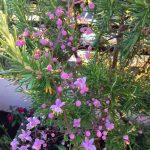
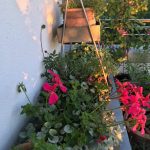
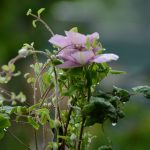
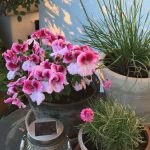
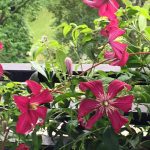
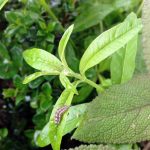
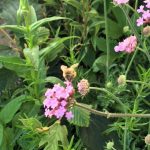
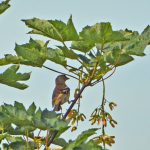
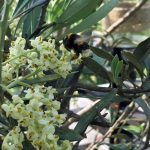
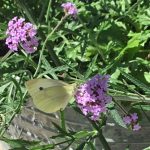
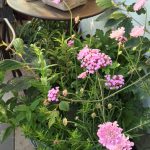
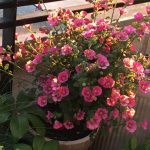
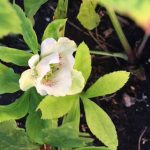
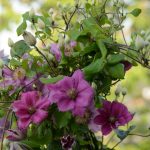
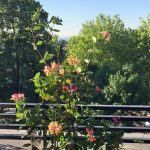
Poor M – as well as compost in the main bedroom you are going to have Tulbaghia and Anisodontea as well (in the winter) and presumably the Hellebores in summer!!
Well I am hopeful that as another variety of Tulbaghia was even flowering while it snowed last winter (presumably because the roots were still warm enough) the new plants will manage too if I can find a sheltered spot. Over-wintering the Anisodontea I can see will be much more challenging, but I have got the possibility of using a space surrounded by the warmth of the building on three sides. Pelargoniums too have survived with their backs against the bedroom wall and their faces catching the winter sun but I agree this is all rather optimistic.
It all looks lovely. By the sound of it I wouldn’t be surprised if the pigeons have a go at nesting in the olive tree. They only seem to need a few twigs for a nest. Have your tried those squirrel proof bird feeders?
I hadn’t anticipated nesting pigeons, but serendipitously a shoot from a new clematis has scrambled through the olive, hopefully obstructing the path of any birds seeking a new home – I’m not sure that clematii climbing through olives are a recommended plant combination but actually particularly lovely when the early light catches the silver leaves.